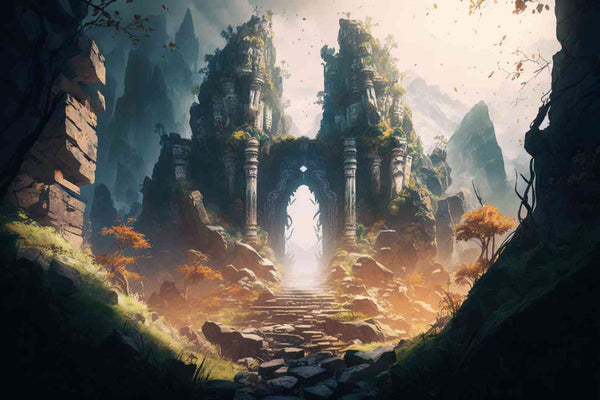Lost Treasures and Hidden Secrets: Unearthing the Wonders of Ancient Ruins in Dungeons & Dragons
Ruins of ancient empires have always been a popular element in Dungeons and Dragons (D&D), RPG, and adventure campaigns. They provide interesting opportunities for players to explore and uncover lost technologies, forgotten cultures, and the secret history of your game. As a DM, you can use these ruins to enhance your campaign by adding depth and intrigue to your world-building. But what is the importance of these ruined cultures in your campaign? Let's explore this question by looking at the legacy of real ancient empires, technologically advanced ruined cultures, and primitive ruined cultures. Then we'll dive in to see how was can use this to our advantage.
Why Have Ancient Empires In Your Campaign?
One of the main reasons to include ancient empires in your campaign is to create a 3-dimensional aspect of historical depth and realism. By adding ancient ruins, you can make your world feel like a living, breathing place with a rich history. These ruins can also serve as a hooks for new quests, offering players a chance to explore new leads, forgotten lands, and probably most importantly lost treasure! Additionally, ancient empires can be used to create conflict between factions or nations vying for control of the ruins. Read on you you'll see why this is important.

How Ruined Cultures Affect Historical Timelines
When incorporating ancient ruins into your campaign, it's important to decide where their place was in your world's timeline. Then decide how this culture played a role in shaping the current world as it is today. Are there remnants of the culture still being used by civilizations? By answering a few simple questions, you can give your campaign a sense of continuity and coherence across a long swath of time. Ruins act as the perfect link to the past. For example, a ruined civilization that was destroyed by a magical catastrophe could explain why certain spells or items are rare or forbidden in the current era.
Legacy of Real Ancient Empires
Real ancient empires, such as the Roman Empire, the Mayan Empire, and the Egyptian Empire, have left a lasting impact on history and culture which can easily be traced back. By including these empires in your campaign, you can tap into their legacy and give your world a sense of that same history. Players may recognize the architecture, symbols, or mythology of these empires, adding to their immersion in the game world. Moreover, the real history of these empires can serve as inspiration for your campaign's events and characters. Even just jotting down a few notes in a campaign setting with a fantasy version of the Roman Empire could feature a rebellion against a tyrannical emperor, or a quest to find a lost artifact that belonged to Julius Caesar.
Setting Back The Clock
Ancient ruins often hold secrets and mysteries from a cataclysmic past that can reveal much about a society's rise and fall. Catastrophic events such as a magical calamity, natural disasters, wars, or plagues can set back the progress of a culture by decades or even centuries. However, they can also pave the way for new opportunities and cultural advancements to emerge. Similar to the destruction of Pompeii, a catastrophic event can wipe out entire societies and create a blank slate for other civilizations to scoop up the power vacuum left in its wake. Exploring ancient ruins can be a valuable tool to allow for player insights into the past and help understand how societies have evolved over time.
Technologically Advanced Ruined Cultures
 Ruined cultures that were technologically advanced offer players a chance to explore lost technologies and futuristic concepts. These ruins could feature advanced machinery, magical artifacts, or even spacecraft. They are also great reasons to 'randomly' place in that steampunk magic train or Spelljammer technology that you always wanted to! By incorporating these ruins into your campaign, you can create a sense of that 3D history placing players at the point of discoveries beyond their understanding. Additionally, these ruins can be used to create factions that seek to control or exploit those same lost technologies, adding a political dimension to the game. For example, a campaign set in a ruined city of a highly advanced civilization could feature a struggle for control over a powerful energy source that made ancient Spelljammer vessels fly. Now that's a worthy quest!
Ruined cultures that were technologically advanced offer players a chance to explore lost technologies and futuristic concepts. These ruins could feature advanced machinery, magical artifacts, or even spacecraft. They are also great reasons to 'randomly' place in that steampunk magic train or Spelljammer technology that you always wanted to! By incorporating these ruins into your campaign, you can create a sense of that 3D history placing players at the point of discoveries beyond their understanding. Additionally, these ruins can be used to create factions that seek to control or exploit those same lost technologies, adding a political dimension to the game. For example, a campaign set in a ruined city of a highly advanced civilization could feature a struggle for control over a powerful energy source that made ancient Spelljammer vessels fly. Now that's a worthy quest!
Primitive Ruined Cultures
More often than not, you'll likely be incorporating primitive ruins in comparison to the current era of your campaign. These ruins could feature crude weapons, ancient cult religions, or simple architecture. As players try to unravel the secrets of the past, they'll be able to uncover a little crumb trail of facts that ultimately lead to the current era of your timeline. Additionally, these ruins can be used to create moral dilemmas as players encounter a different set of ethics or honor code. Imagine an ancient tribe that worshipped a giant stone idol, with intricate carvings and religious ceremonies. Players could explore the ruins of this civilization only to realize that it only works by making live sacrifices. Who better to sacrifice than nearby villagers (just saying!).
More Reasons To Explore
 Not enough reasons you say? Then here are 9 more reasons why you might want to incorporate ancient ruins into your game:
Not enough reasons you say? Then here are 9 more reasons why you might want to incorporate ancient ruins into your game:
- Treasure hunting: The classic reason for exploring ruins is treasure! Ancient artifacts and magical items are bound to be more valuable than gemstones and gold.
- Quests and missions: Players may receive quests or missions that require them to explore ancient ruins to retrieve important items or to uncover valuable information.
- Historical and/or cultural significance: Setting quests inside ancient ruins allows players to learn more about the lore and mythology of your setting.
- Puzzle-solving: Many ancient ruins can be designed as puzzles or mazes, with traps, hidden passages, and intricate mechanisms that must be deciphered and solved. Of course, there must be a reason for all the puzzles and misdirection at the end.
- Combat and challenge: What are ruins without those weird and dangerous monsters that you found in the Monster Manual and didn't have a place for in the normal world?
- Archaeology and exploration: Some players just enjoy the exploration and discovery aspects of RPGs which is why ancient ruins can be a fascinating and immersive area to explore.
- Roleplaying opportunities: Exploring ancient ruins can provide ample opportunities for roleplaying, from deciphering ancient scripts and interacting with ancient spirits to negotiating with primitive factions and uncovering hidden secrets.
- Character development: Characters may gain new abilities or levels by exploring ancient ruins dedicated to forgotten gods, as well as uncovering new aspects of their backstory or personality that they have not explored before.
- Setting development: Most importantly, ancient ruins can help develop the setting of your campaign, providing a rich and detailed history that can shape the political, social, and cultural landscape of the world.
The Importance of The Past
Incorporating ancient empires into your Dungeons and Dragons campaign can provide a wealth of benefits. Whether you choose to include technologically advanced ruins or primitive cultures, there are numerous real-world examples that can serve as inspiration for your campaign. So next time you're planning your adventure, consider incorporating some ancient empires into your world - your players will thank you for it.

